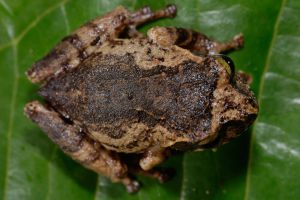
Frogs of Borneo

Frogs of Borneo

Frogs of Borneo

Frogs of Borneo

Frogs of Borneo

Frogs of Borneo

Frogs of Borneo

Frogs of Borneo

Frogs of Borneo

Frogs of Borneo

Frogs of Borneo
Bornean Families
Philautus:
petersi
Peter’s Bush Frog
The localities of the type series of this species include Gunung Penrissen, Gunung Kinabalu, Gunung Dulit, and Great Natuna Island. Given that this species belongs to a highly variable Philautus species group and that no genetic sequence is available from the type series, the coherence of specimens from these widely separated localities across northern Borneo needs to be corroborated. The specimens shown in the image gallery were photographed at Mesilau, Kinabalu, at approximately 2000 m a.s.l. The species is generally reported from elevations above 1000 m.
Philautus petersi is a small, stout brown bush frog. Males reach approximately 20–26 mm in snout–vent length, females 23–37 mm. A snout tubercle is present in females, resulting in a pointed snout, whereas the snout is rounded in males. The nostrils are slightly elevated.
All digits terminate in rounded adhesive pads, and the toes are half-webbed. The limbs are moderately long.
The skin texture is finely pebbled or granulated. A slightly curved supratympanic fold is distinct, while the eardrum is indistinct. Small tubercles are present on top of the eyelids and the head, and some are arranged along the mandible. A small tubercle is commonly present at the heel. The pupil is horizontally oriented and elliptical in shape.
Coloration is highly variable. In specimens from the Mesilau locality, shades of light and dark brown dominate dorsally. These specimens often show white blotches along the lower flanks. As in some other Philautus species, a transverse line may be present between the eyes, separating different color tones anteriorly (snout) and posteriorly. The iris is golden in the upper part and paler, more silvery in the lower part, both with moderate dark reticulation and brownish anterior and posterior sectors.
The biology of this species is virtually unknown. Calling males have been observed perching relatively low on vegetation, 0.5–3 m above the ground. The reproductive mode remains unknown.
Version tracking
-
29.10.2025
updated





